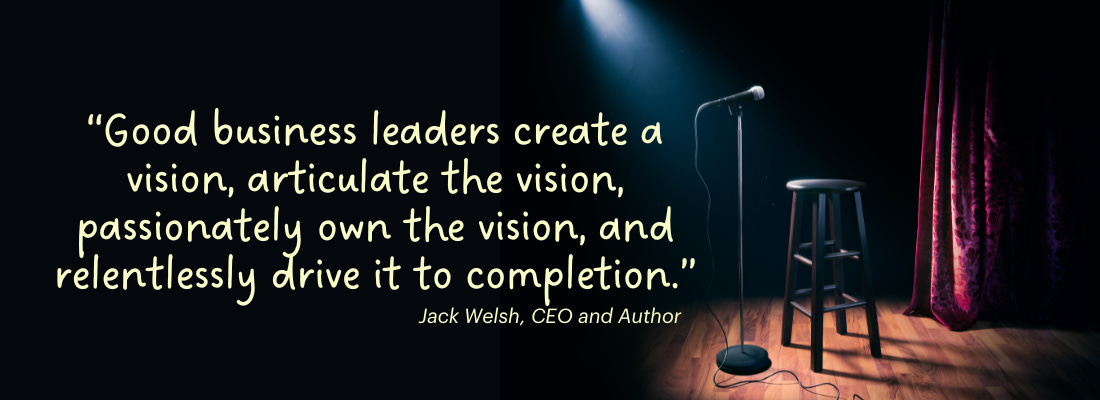Building Your Communication Stage
An effective communication strategy starts with determining clear objectives, including solid motivation behind the message. You can begin by answering three questions: Why? How? What?
Over the past two weeks, we discussed defining your IT Strategy and Governance practice and disciplines. These strategic activities won't make a difference unless you share them! Now is an excellent time to build your communication strategy.
A communication strategy is critical to bridging the purpose and implementing your vision or any significant change program. It is a well-defined, written plan that details the stakeholders and how the message will reach its audience.
An effective communication strategy starts with determining clear objectives, including solid motivation behind the message. You can begin by answering three questions:
Why is it important to YOU as the IT Leader to inform your IT team and stakeholders of the IT Department Vision, Mission, Values and Principles and the overall IT strategy?
What can they expect to see differently?
How will the change be implemented?
Knowing the answers to these simple questions will articulate the intentions and outcomes of the strategy.
To validate the assumption behind your answers as well as develop your communication strategy, my recommendation for a planning approach follows three phases:
Prepare
Identify the gaps between the existing behaviors and capabilities and the future state desired outcomes.
Define your change management strategy and communication approach
Who are your stakeholders? What do they need to know?
How will you present the strategy, vision, mission, and values?
What activities will bring the changes to life for the stakeholders?
What communication platforms will you use with which stakeholders (e.g., all-hands, 1:1 conversation, email messaging, recorded video)?
Prepare your change management team.
Who is your change management team?
What are their roles and responsibilities?
How will you ensure everyone is delivering the same message?
Role-playing and practice
Frequently asked questions
Develop your sponsorship model
Is your upline executive on board and behind you?
Who must you vet the change and communication plan to ensure their support?
Manage
Develop change management plans
Develop and execute action and implementation plans
Reinforce
Collect and analyze feedback
Diagnose gaps and manage resistance
Implement corrective actions
Celebrate successes
As you build and execute your communication strategy, you must have a solid foundation to launch from, a willingness to trial, and be open to adjusting your approach based on experience and feedback. With that, I offer you tips from personal experience:
People won't just open up to those they don't trust. You can't force trust. You must earn it. You achieve it by acting and thinking right. Be honest with yourself and acknowledge gaps in trust with stakeholders. Most importantly, work authentically to gain (or regain) their trust. (Reach out if you need help with how.)
Know what and who you need to communicate with personally and to whom you can delegate. The what and who is amplified by how much change is planned or needs to occur. Take the time necessary to ensure all delegates represent the collective message and are not slanted with their personal agenda. Bring the delegates together periodically, daily or weekly, to share the context and feedback from the conversations. In other words, own the delivery even if someone is representing you.
An essential part of good communication is listening. Never try to end your conversation if you don't hear and understand what is being spoken. Have you ever been amazed at the memory of great leaders? It is because they listen. Listen well and respond appropriately. Listening skills are the foremost thing you must possess to improve your communication skills.
Don't jump to conclusions based on one person's conversation. Listen to others before reacting. Multiple inputs enable us to form the best opinion.
Once you have listened and comprehended what you have heard, take the time necessary to think and then plan what you want to say. There is no foul in thinking before you react. Wars start when one does not stop to think first.
Believe it or not, we are not always right. Sometimes we make mistakes. It is important to admit it and understand where your thinking may have gone wrong. Acknowledge it and adjust from there.
Train yourself to focus. It is becoming more demanding and challenging due to multi-tasking and the overwhelming amount of information coming our way. We must try never to allow our minds to roam or dream while we are speaking or listening. Not only is it offensive, but you are guaranteed to miss the point.
Don't hesitate to ask someone to repeat, rephrase, or slow down. I will admit I am accent-challenged. My slightly dyslexic brain does not decipher accents well. I have grown beyond pretending I understand when I don't. It is not worth the risk of misunderstanding and it is rude.
Make a point of observing yourself when you communicate with others. Take note of your body language. Body language's impact on communication can be a whole session or two by itself. Our facial expressions and body stances significantly impact how well we are heard and how comfortable people are with sharing feedback. If you stop to think about it, you will understand the concern.
As I finish up today's article, I realize that some may feel I am overstating the importance of building the stage to communicate your strategy purposefully. You may be thinking – why can't we just execute and take it from there?
You certainly can, and it may work. At the same time, you will miss the opportunity to ensure awareness and expectations behind the vision and mission. More importantly, you will miss the opportunity to partner with your stakeholders and solicit their involvement in executing your strategy.
Until next time, have an effective week! To further this week's conversation - Let's Talk!
Warm regards, Mary




